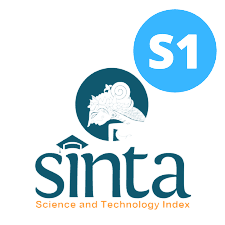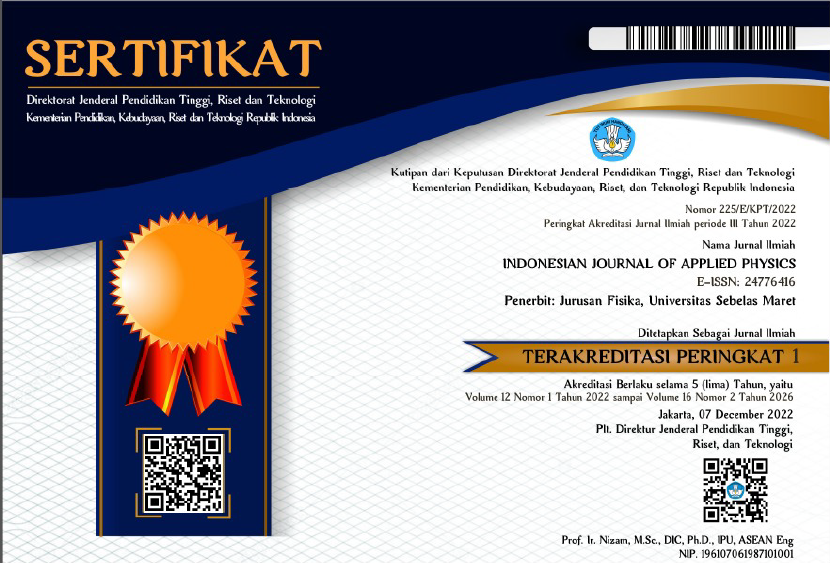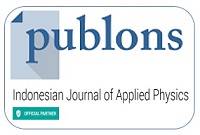Adsorption Behavior of Sugarcane Bagasse-Derived Activated Carbon as a Copper Removal
Abstract
This study aims to remove Cu2+ as a heavy metal inside the sample solution implementation. Eliminating heavy metals through activated carbon utilizes sugarcane bagasse's high carbon content, which is rich in cellulose, lignin, and hemicellulose. There are various methods for eliminating metal content, including activation using Acid 0.1 M Hydrochloric Acid (HCl), Base 0.1 M Sodium Hydroxide (NaOH), and without using activation media. The method considers the different ion Cu2+ initial concentrations and contact times. Detailed initial concentrations of Cu2+ were conducted using CuSO4 media for 2.5, 5, 10, and 15 ppm and 15, 30, 60, and 120 minutes for length of contact time. For the result, the transmittance of FTIR showed a primary functional group of Activated Carbon (AC) on SBAC-1, comprising O-H, C-O, and C=O. The Brunauer-Emmett-Teller (BET) analysis also shows the significant value reaching 458.607 m2/g surface area's adsorption and had qmax = 8.13 mg/g, the highest adsorption capacity. The plot brings about the adsorption mechanism as physiochemical & multilayer adsorption, with a physisorption layer with percent removal of Cu2+ at 81.3% at 30 minutes optimum time and optimum initial concentration of 5 mg/L with 82.2 % absorption on SBAC-1. The determination of Freundlich as the isotherm model is the most suitable mechanism of absorption for all process variations and generates a R2 value of 0.9731 for the SBAC-1 sample.
Keywords
Full Text:
PDFReferences
1 Amanah, N. L., Djafar, E., Widharyanti, I. D., & Nugroho, A. 2023. Inhibition efficiency of water-soluble chitosan inhibitor from fish scales waste on low carbon steel SS400 in NaCl solution. AIP Conference Proceedings, 2743(1), 20010.
2 Amanah, N. L., Widharyanti, I. D., & Nugroho, A. 2021. Synthesis of water-soluble chitosan inhibitor from shrimp shells and its corrosion rate on mild steel in acidic solution. Journal of Physics: Theories and Applications, 5(1), 9–17.
3 Velusamy, S., Roy, A., Sundaram, S., & Kumar Mallick, T. 2021. A Review on Heavy Metal Ions and Containing Dyes Removal Through Graphene Oxide-Based Adsorption Strategies for Textile Wastewater Treatment. The Chemical Record, 21(7), 1570–1610.
4 Rajoria, S., Vashishtha, M., & Sangal, V. K. 2022. Treatment of electroplating industry wastewater: a review on the various techniques. Environmental Science and Pollution Research International, 29(48), 72196–72246.
5 Chaemiso, T. D. 2019. Removal Methods of Heavy Metals from Laboratory Wastewater. Journal of Natural Sciences Research.
6 Nugroho, A., Amanah, N. L., & Firdaus, R. G. 2022. Adsorption study of mango peel activated carbon as iron removal for batik waste industry. Jurnal Rekayasa Proses, 16(1), 19–24.
7 Amuda, O. S., Giwa, A. A., & Bello, I. A. 2007. Removal of heavy metal from industrial wastewater using modified activated coconut shell carbon. Biochemical Engineering Journal, 36(2), 174–181.
8 Kadirvelu, K., Kavipriya, M., Karthika, C., Radhika, M., Vennilamani, N., & Pattabhi, S. 2003. Utilization of various agricultural wastes for activated carbon preparation and application for the removal of dyes and metal ions from aqueous solutions. Bioresource Technology, 87(1), 129–132.
9 Masoud, M. S., El-Saraf, W. M., Abdel - Halim, A. M., Ali, A. E., Mohamed, E. A., & Hasan, H. M. I. 2016. Rice husk and activated carbon for waste water treatment of El-Mex Bay, Alexandria Coast, Egypt. Arabian Journal of Chemistry, 9, S1590–S1596.
10 Zakir, M., Kasim, H., Raya, I., Lamba, Y., Nuratisah, & Belen Jorge, A. 2019. Performance of Candlenut Shell (Alleuretus moluccana) Based Supercapacitor Electrode with Acid Electrolytes and Their Salts. IOP Conference Series: Materials Science and Engineering, 619(1), 12042.
11 Dias, M. O. S., Ensinas, A. V, Nebra, S. A., Maciel Filho, R., Rossell, C. E. V, & Maciel, M. R. W. 2009. Production of bioethanol and other bio-based materials from sugarcane bagasse: Integration to conventional bioethanol production process. Chemical Engineering Research and Design, 87(9), 1206–1216.
12 Chandel, A. K., Albarelli, J. Q., Santos, D. T., Chundawat, S. P., Puri, M., & Meireles, M. A. A. 2019. Comparative analysis of key technologies for cellulosic ethanol production from Brazilian sugarcane bagasse at a commercial scale. Biofuels, Bioproducts and Biorefining, 13(4), 994–1014.
13 Ghosh, A., Chakravorty, D., Rahaman, M., & Bose, S. 2019. Efficiency of Mango Peel Derived Activated Carbon Prepared via Different Routes as Adsorbent for Rhodamine B BT - Waste Water Recycling and Management. In S. K. Ghosh (Ed.) (pp. 111–122). Singapore: Springer Singapore.
14 Nasti, A. N. De, Siburian, K. Y., Sembiring, A. D., Kristianto, H., Susanti, R. F., Oktaviano, H. S., & Nugroho, A. 2023. Carbon composite of NiO hydrothermal impregnation from sugarcane bagasse and its electrochemical properties. Jurnal Rekayasa Proses; Vol 17, No 2 (2023)DO - 10.22146/Jrekpros.88210 .
15 Agarwal, A. K., Kadu, M. S., Pandhurnekar, C. P., & Muthreja, I. L. 2013. Removal of Nickel (II) ions from aqueous solution using thermal power plant fly ash as a low cost adsorbent: Adsorption isotherm and kinetics study. International Journal of Environmental Protection, 3(3), 33.
16 Heidarinejad, Z., Dehghani, M. H., Heidari, M., Javedan, G., Ali, I., & Sillanpää, M. 2020. Methods for preparation and activation of activated carbon: a review. Environmental Chemistry Letters, 18(2), 393–415.
17 Lillo-Ródenas, M. A., Cazorla-Amorós, D., & Linares-Solano, A. 2003. Understanding chemical reactions between carbons and NaOH and KOH: An insight into the chemical activation mechanism. Carbon, 41(2), 267–275.
18 Kwaghger, A., & Ibrahim, J. S. 2013. Optimization of conditions for the preparation of activated carbon from mango nuts using HCl. American Journal of Engineering Research, 2(7), 74–85.
19 Hassan, A. F., Abdel-Mohsen, A. M., & Fouda, M. M. G. 2014. Comparative study of calcium alginate, activated carbon, and their composite beads on methylene blue adsorption. Carbohydrate Polymers, 102, 192–198.
20 Kim, D., Lee, K., & Park, K. Y. 2016. Upgrading the characteristics of biochar from cellulose, lignin, and xylan for solid biofuel production from biomass by hydrothermal carbonization. Journal of Industrial and Engineering Chemistry, 42, 95–100.
21 Guo, Y., Tan, C., Sun, J., Li, W., Zhang, J., & Zhao, C. 2020. Porous activated carbons derived from waste sugarcane bagasse for CO2 adsorption. Chemical Engineering Journal, 381, 122736.
22 Kiełbasa, K., Bayar, Ş., Varol, E. A., Sreńscek-Nazzal, J., Bosacka, M., Miądlicki, P., … Michalkiewicz, B. 2022. Carbon Dioxide Adsorption over Activated Carbons Produced from Molasses Using H2SO4, H3PO4, HCl, NaOH, and KOH as Activating Agents. Molecules.
23 Sricharoenchaikul, V., Pechyen, C., Aht-ong, D., & Atong, D. 2008. Preparation and Characterization of Activated Carbon from the Pyrolysis of Physic Nut (Jatropha curcas L.) Waste. Energy & Fuels, 22(1), 31–37.
24 Beyan, S. M., Prabhu, S. V., Ambio, T. A., & Gomadurai, C. 2022. A Statistical Modeling and Optimization for Cr(VI) Adsorption from Aqueous Media via Teff Straw-Based Activated Carbon: Isotherm, Kinetics, and Thermodynamic Studies. Adsorption Science & Technology, 2022, 7998069.
25 Cheng, L., Jiang, Y., Qi, S.-C., Liu, W., Shan, S.-F., Tan, P., … Sun, L.-B. 2018. Controllable Adsorption of CO2 on Smart Adsorbents: An Interplay between Amines and Photoresponsive Molecules. Chemistry of Materials, 30(10), 3429–3437.
26 Tan, Y. H., Davis, J. A., Fujikawa, K., Ganesh, N. V., Demchenko, A. V, & Stine, K. J. 2012. Surface area and pore size characteristics of nanoporous gold subjected to thermal, mechanical, or surface modification studied using gas adsorption isotherms, cyclic voltammetry, thermogravimetric analysis, and scanning electron microscopy. Journal of Materials Chemistry, 22(14), 6733–6745.
27 Naderi, M. 2015. Chapter Fourteen - Surface Area: Brunauer–Emmett–Teller (BET). In S. B. T.-P. in F. and S. Tarleton (Ed.) (pp. 585–608). Oxford: Academic Press.
28 Wang, S., Lu, L., Wu, D., Lu, X., Cao, W., Yang, T., & Zhu, Y. 2016. Molecular Simulation Study of the Adsorption and Diffusion of a Mixture of CO2/CH4 in Activated Carbon: Effect of Textural Properties and Surface Chemistry. Journal of Chemical & Engineering Data, 61(12), 4139–4147.
29 Tan, P., Bao, Y.-F., Liu, D.-H., Liu, X.-Q., & Sun, L.-B. 2023. Photomodulation on Active Sites of Adsorbents: Controllable Adsorption Processes with Improved Efficiency. Chemistry – A European Journal, n/a(n/a), e202300553.
30 Sari, A. P., Rhamadani, F. A., Amanah, N. L., & Nugroho, A. 2022. Study of Efficiency and Reaction Rates Dechlorination of Nata De Coco Wastewater Using Sodium Thiosulfate. Journal of Emerging Supply Chain, Clean Energy, and Process Engineering , 1(2 SE-ARTICLES), 107–116.
31 Wasewar, K. L. 2010. Adsorption of metals onto tea factory waste: a review. International Journal of Research, 3, 303–322
32 Kalam, S., Abu-Khamsin, S. A., Kamal, M. S., & Patil, S. 2021. Surfactant Adsorption Isotherms: A Review. ACS Omega, 6(48), 32342–32348.
33 Ragadhita, R., & Nandiyanto, A. B. D. (n.d.). How to Calculate Adsorption Isotherms of Particles Using Two-Parameter Monolayer Adsorption Models and Equations. Indonesian Journal of Science and Technology; Vol 6, No 1 (2021): IJOST: April 2021DO - 10.17509/Ijost.V6i1.32354 .
34 Mohammed, I., Afagwu, C. C., Adjei, S., Kadafur, I. B., Jamal, M. S., & Awotunde, A. A. 2020. A review on polymer, gas, surfactant and nanoparticle adsorption modeling in porous media. Oil Gas Sci. Technol. – Rev. IFP Energies Nouvelles, 75.
35 Raji, Z., Karim, A., Karam, A., & Khalloufi, S. 2023. Adsorption of Heavy Metals: Mechanisms, Kinetics, and Applications of Various Adsorbents in Wastewater Remediation—A Review. Waste.
36 Sobolev, K. V, Magomedov, K. E., Shilov, N. R., Rodionova, V. V, & Omelyanchik, A. S. 2023. Adsorption of Copper Ions on the Surface of Multilayer Ti3C2Tx MXenes with Mixed Functionalization. Nanobiotechnology Reports, 18(1), S84–S89.
Refbacks
- There are currently no refbacks.
















